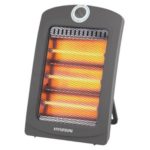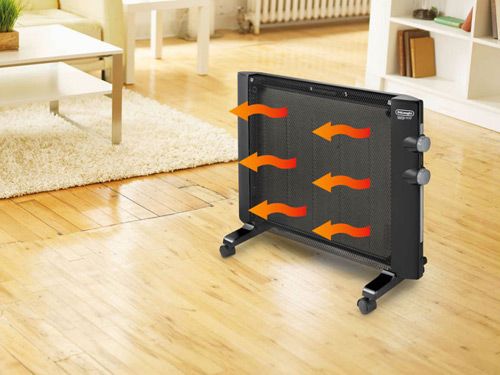Pros and cons of a quartz heater
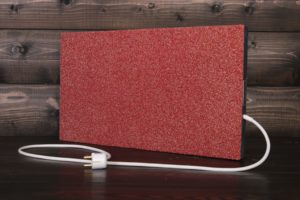 Heating of premises is not always carried out using a central heating system. The modern market offers a wide variety of devices designed for heating residential premises. Similar devices include a quartz heater, which appeared on the market approximately 10 years ago. Despite the fact that such devices are inferior in performance characteristics to gas heating, they compare favorably with cost and amount of energy consumed.
Heating of premises is not always carried out using a central heating system. The modern market offers a wide variety of devices designed for heating residential premises. Similar devices include a quartz heater, which appeared on the market approximately 10 years ago. Despite the fact that such devices are inferior in performance characteristics to gas heating, they compare favorably with cost and amount of energy consumed.
The content of the article
How does a quartz heater work?
The essence of the functioning of this heating product, made of quartz sand, is the use of directed infrared radiation. In essence, this is an analogue of a natural process. In a similar way, the earth is warmed by the sun.
REFERENCE! The basis for the production of each glass is silicon of natural origin (sand). The windows in any apartment can be called quartz, since their translucent part is made of sand.
Design of infrared quartz heaters
- Heating coil.Consists of an alloy of nickel and chromium (nichrome). Due to the presence of quartz sand in the unit, heat transfer is increased and protected from environmental influences. The heating coil is immersed in a special lamp, the body of which is made of quartz glass.
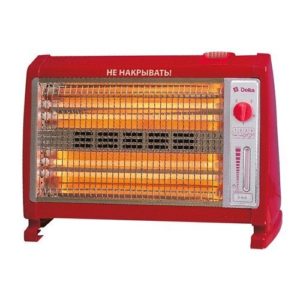
- Diffuser. It is made of metal. This element is a plate placed behind the plate or flask, which acts as a specific reflective surface. Infrared rays begin to reflect from this surface, which, in turn, allows for directed radiation.
- Thermostat. Helps reduce space heating costs by 30–40%. Certain devices equipped with an integrated control unit function completely autonomously. Some require a thermostat connection. In order to ensure safe operation, sensors are installed in the heaters to protect the surface from overheating.
The use of quartz filler ensured safety, economy and an impressive period of use. Even when the heating source is turned off, the sand still retains heat for some time. Heating devices made on the basis of quartz sand begin to realize the required operating power 20 minutes after switching on.
In order for the device to work properly for a long time, it is advisable to follow the manufacturers' recommendations:
- do not overload the electrical network;
- the device must not be covered;
- it is necessary to turn off such devices at night;
- you need to leave a distance of at least 50 cm between the wall and the device body;
- The heaters cannot be placed opposite each other; this can only be done in a checkerboard pattern.
Pros and cons of quartz heaters
There are two types of such heating devices: infrared and monolithic. Each of these types has a number of certain advantages and disadvantages.
Advantages of monolithic quartz devices:
- reasonable cost of the product;
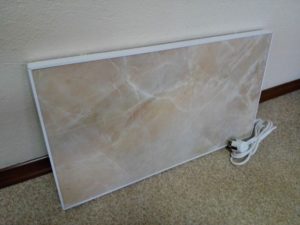
- absence of noise during operation;
- simplicity of design;
- environmental friendliness;
- quick heating of the room thanks to two methods of heat transfer - infrared radiation and convection.
Flaws:
- heavy weight and the need for strong fastening in case of wall placement;
- the material of the plates is very fragile (they often break during transportation);
- unattractive appearance;
- inability to directly plug the device into a power outlet (you have to additionally buy a thermostat and connect it to the battery);
- excessively high surface temperature (95 °C) can cause burns (it is advisable to use it together with a protective screen, which is purchased separately).
Advantages of infrared heating devices:
- compact size (easily fits under furniture);
- fast heat generation (2–3 minutes after switching on);
- can be mounted in any convenient way: on the wall or on a stand;
- original design.
Flaws:
- fragility of the glass tube;
- high probability of getting burned;
- no thermostat.
REFERENCE! Infrared quartz heaters are suitable for installation directly on the street for local heating of people, since such devices are characterized by their ability to increase the temperature of surfaces in a short time.
Types of quartz heaters
Let's consider the operating principle and features of monolithic and infrared heating devices.
Monolithic
They are made from a special mixture that includes quartz sand. The prepared solution is poured into a special flat mold, into which a nichrome spiral, which has reliable electrical insulation, and a reinforcing frame are first placed. Then they are compacted, dried and baked.
Standard dimensions of a quartz heater of this type: 61x34x2.5 cm. Average weight is approximately 10 kg. The monolithic heater plate is about 25 mm wide. During operation, the temperature of the heater itself is 120 °C, and the temperature of the plate is 95 °C. Power consumption is 400–500 W. The surface of the device is usually textured or smooth.
If the color of the purchased quartz heater leaves much to be desired, you can always paint it in the desired shade. This will not affect the functionality of the device in any way.
Infrared
The function of radiation propagation in this product is performed by a tungsten spiral placed in a quartz tube. The quartz tube protects the coil from contact with dust and other types of particles. When the spiral heats up noticeably and acquires a bright scarlet color, dust and microscopic particles burn when they come into contact with it, releasing an unpleasant odor.
The weight of such devices is relatively small - from 1 to 3 kg. The power consumption of household models is 1–3 kW. ABOUTOne device can have several 400–500 W heaters, each of which is equipped with its own switch.
ATTENTION! When painting a quartz slab, it is recommended to choose heat-resistant paint that does not release toxic substances when heated.
Scope of application of quartz heating devices
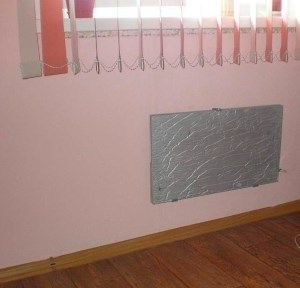 In many respects, such devices are better than conventional heaters, which have disadvantages related to the characteristics of their operation. When producing a quartz heater, manufacturers took into account all the shortcomings. The result is more advanced equipment that is economical and durable.
In many respects, such devices are better than conventional heaters, which have disadvantages related to the characteristics of their operation. When producing a quartz heater, manufacturers took into account all the shortcomings. The result is more advanced equipment that is economical and durable.
REFERENCE! Infrared radiation helps activate the human immune system and accelerate regenerative processes in cells.
Heating devices based on quartz are used in industrial or residential premises. In addition, such devices are often used in production if it is necessary to dry painted surfaces.
The main areas of use of quartz heaters
- for heating stadiums, restaurants and other open areas;
- for heating residential premises;
- in clinics and other medical institutions.
Such a device can be used as a main or additional heat source. If a special stand is available, such a heater can be used, among other things, to warm up the engine in a car.
What criteria need to be taken into account when choosing
When choosing a quartz heating device, you need to take into account certain characteristics and capabilities.
Device power
When planning heating, it is necessary to take measurements of the rooms. It is better to choose the appropriate option based on the following principles:
- up to 10 m² - one device with a power of 500 W;
- from 10 to 15 m² - two 400 W devices;
- from 15 to 20 m² - two 500 W heaters;
- from 20 m² - one 500 W device for every 7 m².
Manufacturer
Monolithic panels require high-quality maintenance, but not every city has suitable service centers.This information must be clarified in detail before purchasing.
REFERENCE! The longer the warranty period, the more you should trust the manufacturer of such a product.
Additional features
If there is a need for a built-in timer, the ability to automatically turn off or adjust the temperature, you must check in advance whether the selected model has them.
Amount of energy consumed
Some quartz heating devices can have an attractive price, but at the same time consume an impressive amount of energy. Therefore, you need to pay attention to this parameter when choosing the appropriate option.


